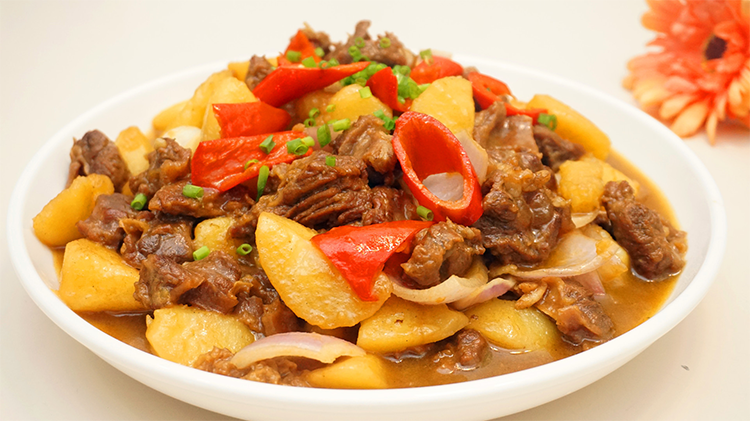Tibetan Yak and Potato Stew
1. Tibetan Yak and Potato Stew: A High‑Plateau Comfort
On the Roof of the World, there’s a dish that warms the body and soul: Tibetan yak and potato stew. This hearty, savory comfort food uses two high‑altitude staples—yak meat and potatoes—and embodies the survival wisdom and hospitality of Tibetan life. When rich meat aroma blends with meltingly soft potatoes, you taste the pure, solid flavors of the plateau.
2. Origins: Survival in Wind and Snow
The origins of yak and potato stew are inseparable from Tibet’s harsh environment and nomadic culture. Yaks—called the “boats of the plateau”—are indispensable to Tibetan life, providing transport, milk, meat, and wool. Potatoes, introduced to China in the Ming and Qing eras, thrived on the plateau because of their cold tolerance and high yield, becoming a key staple.
During long, bitter winters, people needed high‑calorie, nutritious food to stay warm and maintain energy. Dried or preserved yak meat combined with stored potatoes, slowly simmered for hours, produced a nourishing, warming stew. Born from basic survival needs, this dish is a vivid symbol of endurance and practical cooking passed down through generations.

3. Cultural Meaning: Shared Heat and Hospitality
In Tibet this stew goes beyond nourishment; it represents community and sharing. Typically served in a large pot or communal bowl, families and friends gather around to eat together—an expression of unity and goodwill.
When a traveler arrives, offering a bubbling pot of yak and potato stew is one of the highest forms of hospitality. The dish carries welcome and blessing. During Tibetan New Year and other festivals, it often appears at the table as a sign of abundance. Tasting the stew is as much a cultural experience as a culinary one.
4. Ingredients from the Plateau: Pure Gifts
The dish’s distinctive taste comes from Tibet’s pure, high‑altitude ingredients.
- Yak meat: Raised on pastures above 3,000 meters, free‑range yaks are lean, muscular, and richly flavored. Their meat is firm with pronounced beefy notes, low in fat but high in protein and amino acids—offering a texture and depth different from ordinary beef.
- Potatoes: Plateau potatoes develop a high starch content in the region’s big temperature swings and strong sunshine. They become powdery, slightly sweet, and hold together well during long stews, soaking up the broth’s essence.
- Simple seasonings: Salt, fresh ginger, Sichuan peppercorns, dried chilies, and scallions are usually enough. Traditional recipes avoid overwhelming spices to highlight the primary ingredients. The cooking water is often clear spring or snowmelt from the highlands.

5. How It’s Made: Time Builds Flavor
Traditional cooking values patience and low heat to meld flavors.
- Cut yak meat into large chunks and blanch in cold water to remove impurities.
- Place the cleaned meat in a large pot, add plenty of water, ginger slices, and Sichuan peppercorns. Bring to a boil, then simmer slowly until the meat becomes tender—several hours over low heat (or use a pressure cooker to shorten the time).
- When the meat is nearly falling apart, add rustic potato chunks and continue simmering for 20–30 minutes until potatoes are cooked through and have absorbed the broth.
- Season with salt to taste and garnish with chopped scallions. The goal is a clear, savory broth and deeply flavored, tender meat.
6. Flavor and Texture: Rustic Complexity
A well‑made yak and potato stew has a clear, golden broth with a shimmer of oil. The meat should be fall‑apart tender yet still show muscle fibers; its flavor is rich and meaty. Potatoes remain intact on the surface but are powdery and soft inside, saturated with the meat broth—often even more delicious than the meat itself. The soup is the heart of the dish: savory, slightly fatty, and instantly warming.

7. How to Eat and Pairings
Best served with traditional Tibetan sides:
- Tsampa (roasted barley flour) or a Tibetan steamed bread. Dip bread in the broth or mix tsampa with the rich stock for a classic experience.
- Butter tea (Tibetan yak butter tea) complements the dish—its salty, fatty richness cuts through the stew and warms you from the inside.
This dish is ideal in cold weather, after long treks, or following strenuous activity—providing quick, comforting energy on the high plateau.
8. Traveler Tips: Where to Find Authentic Flavors
- In restaurants: In Lhasa, Shigatse, and other Tibetan towns, look for the dish listed as “yak and potato stew” or “potato stew with yak meat.” Ask if the meat is braised until tender if you prefer a softer texture.
- Home visits: If invited to a Tibetan household, you’ll likely taste the most authentic, home‑style stew.
- Altitude caution: Newcomers may have sensitive stomachs—eat slowly and in moderation. Drinking butter tea can help with high‑altitude adaptation.

9. Easy Home Version
You can recreate a comforting approximation at home:
- Substitute beef brisket or shank if yak meat is unavailable. Use starchy potatoes like Russets.
- Basic steps: blanch beef, sauté ginger, peppercorns, and chilies, add beef and water, simmer 1.5 hours (or pressure cook 30 minutes), add potatoes and salt, simmer another 20–30 minutes, garnish and serve.
10. Conclusion
Tibetan yak and potato stew is a simple yet profound dish—built from humble ingredients and intense patience. It tells a story of resilience, welcome, and gratitude for the land’s gifts. When you travel to the Tibetan Plateau, don’t miss a steaming bowl—taste the warmth, history, and hospitality of Tibet in every spoonful.


